|
Shellstock tagging has a very direct role in public health protection. In the event of a shellfish related illness, tags are a tool, which, used in concert with records, should provide for trace ability of live shellstock from the final consumer back through every middle man, (retailer, wholesaler, carrier, and dealer) who handled the product, to a specific growing area, harvest date, and ultimately, if possible, the individual person who harvested the shellstock.
When an outbreak of disease attributable to shellfish occurs, health departments and other appropriate state and federal agencies must be able to determine the source of shellfish contamination to prevent any further outbreaks from this source. This can be done most effectively by using the records kept by the shellfish harvesters and dealers to trace a shellfish shipment, through all the various dealers who have handled it, back to its point of origin. Shellstock tags are the first important records concerning the origin of shellfish.
Harvesters must provide information necessary to create a record of the origin, quantity, and date of harvest, which can be used to trace a lot of questionable shellstock back to its source or sources. Investigation of disease outbreaks can be severely hindered if the source of the shellfish cannot be readily identified. Inability to identify the source can result in shellstock from the unacceptable source continuing to be used and continuing to cause illness. Health authorities may be forced to close a safe growing area, to ban a safe shellstock shipment or to seize a safe lot of shellstock as a public health precaution if the source of contaminated shellfish cannot be accurately and rapidly determined.
Maintaining adequate records is considered by some industry members to be a burden. This has resulted in various unacceptable practices being encountered by health officials, including no written records of purchase, undated shellstock shippers tags maintained in an unordered manner, new shipping tags being placed on a lot of shellstock without records to correlate the original identity of the lot with the new identity, and shellfish on the premises with no tags. Although these dealers often have "records" in the most general sense, these records are not in the form that meets the intent of the NSSP certification requirement to provide trace ability on a lot-by-lot basis. As a result, follow-up investigations of disease outbreaks have been stymied, identification of the cause of the outbreak has been delayed, and outbreaks have continued. For more information concerning dealer certification, see the NSSP Guidance Document: Chapter III. 03: Dealer Certification and the Interstate Certified Shellfish Shippers List.
An example where the failure to maintain adequate records was identified as one of the principal contributing factors to a series of continuing shellfish associated disease outbreaks occurred in 1981 and 1982. The outbreaks continued for several months and affected thousands of people. An investigation by the states involved and FDA revealed that some states were unable to enforce the record keeping and tagging requirements of the NSSP. FDA found in one state that approximately one-third of the certified dealers inspected failed to maintain adequate records. State officials realized that an improved tagging, labeling or manifest system was needed to track shellfish in the marketplace back to the distributor and to the harvester.
When a lot of shellstock is sold in bulk (e.g. by the truckload without being placed in containers), the harvester or dealer must provide a transaction record prior to shipment. If the transaction record is generated by the harvester, the record must contain information identical to that required on the harvester’s tags and must also include the name of the consignee. If the transaction record is generated by the dealer, the record must contain information identical to that required on dealer’s tags and must include the name of the consignee.
The NSSP recognizes two types of shellstock tags: harvester tags and dealer tags. Many of the requirements are the same for both tag types. There are some additional requirements for dealer tags when the product has been wet stored or depurated. Transaction records which provide the same information as the harvester’s or dealer’s tag may be used in lieu of tags for lot of shellstock sale and lot of shellstock shipment.
Shellstock harvest location needs to be consistently defined on all tags. The tags should provide the most precise identification of the harvest location or aquaculture site as is practicable; this identification must include at least the state (initials) in which the shellstock were harvested in the designated growing area within the state as assigned by the Authority of the producer state. If harvest areas have not been indexed by the Authority, then an appropriate geographical or administrative designation must be used (e.g. Long Bay, Decadent County, lease number, bed or lot number).
Each harvester or aquaculturist and each dealer must affix an approved, durable, waterproof tag, containing all the information required by the NSSP Model Ordinance, to each container of shellstock. Minimal required tag size is 2 5/8 by 5 1/4 inches (6.7 by 13.3 cm). Example tags are provided in Attachment 1. The harvester's tags must be in place while the shellstock is being transported to the dealer unless the harvest has occurred at more than one harvest location or aquaculture site; then each container must be tagged at the harvest location or aquaculture site. In certain situations, the truck may be considered the container for transport of bulk loads of shellstock from the growing area to the dealer. For dealers, tagging must be done prior to shipment. When the dealer is also the harvester, the dealer's tag may also be used as the harvester's tag.
Information on the harvester's tags must be legible, indelible and arranged in the following specific order:
Dealer tagging is required upon harvest or receipt from a harvester, processing and packaging of shellstock by the dealer, or sale and shipment of shellstock by the dealer to other dealers for subsequent sale, processing or additional packaging. The information on the dealer’s tags must be legible, indelible and arranged in the following specific order:
When both the dealer and harvester tags appear on the container, the dealer tag is not required to list the date of harvesting, and the harvest location or the aquaculture site. A harvester's tag must be in place while the shellstock is being transported to a dealer. The dealer must keep the harvester’s tag in place until the container of shellstock is shipped or until it is broken open for washing, grading and packing. Once the container is broken open, the dealer must:
Except for shellstock that originated from a depuration-processor, shellstock transported across state lines and placed in wet storage must include the following information on its shipping tag after removal from wet storage:
Lot of shellstock tagging in the washing, packing and staging of shellstock is permissible only when the lot container (i.e., the pallet) is tagged as required in a protocol approved by the Authority. The protocol shall provide for lots of shellstock to be separated and identified to prevent commingling or misidentification. The tag on each lot of shellstock shall contain the following minimum information:
ALL SHELLFISH CONTAINERS IN THIS LOT HAVE THE SAME DATE AND AREA OF HARVEST.
Harvest Date__________________________________________
Harvest Area__________________________________________
Original Dealer/Shipper #_________________________________
# of units in this lot container_______________________________
The dealer's tag must be put on all containers of shellstock before they are shipped to another dealer or retailer. Prior to shipment, all containers of shellstock must remain easily identified and continue to be separated to prevent commingling or misidentification. The protocol approved by the Authority shall provide for lots of shellstock to be separated and identified so as to prevent commingling or misidentification. The allowable means of identification are:
In relay operations, the method of shellstock identification (tagging, bulk load records, etc.) is left to the discretion of the Authority. When the relay process is conducted using containers, a need exists to develop a container identification system to locate and avoid removal of containers before the natural cleansing process is complete. Once the relay operation is complete, the shellstock is subject to the tagging requirements for harvesters and dealers.
Shellstock that has been subjected to depuration requires an increased level of control because of the increased potential for contamination. These controls must include packaging and tagging that will serve to help identify the depuration cycle of each harvest lot and to deter illegal commingling of shellstock which has not been depurated with depurated shellstock. The Authority may require the harvester to use special tags or to provide additional information on the tags. At a minimum, the harvester’s tags (or transaction records used for bulk shipments) must identify the growing area, provide the harvester’s special license number, and specify the harvest date and the quantity of shellstock.
The dealer’s (i.e. the depuration processor) tags must, at a minimum, include the following information in a legible and indelible form:
In the event of a shellfish related illness, tags are a tool, which, used in concert with records, should provide for trace ability of live shellstock from the final consumer back through every middle man, (retailer, wholesaler, carrier, and dealer) who handled the product, to a specific growing area, harvest date, and ultimately, if possible, the individual person who harvested the shellstock.
The following options are recommended for inclusion on tags to improve the effectiveness of the NSSP tagging program.
Tag Construction: Durable, waterproof and a minimum size of 2 5/8 inches by 5 1 / 4 inches (6.7 cm by 13.3 cm)
Examples of Shellstock Tags
This tag is an example of a harvester’s tag with the minimum NSSP required information in the required order.
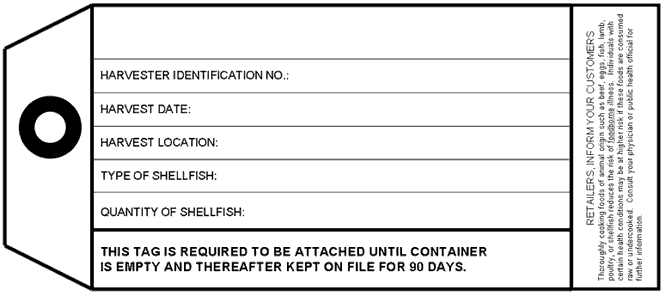
This tag is an example of a dealer’s tag with the minimum NSSP required information in the required order.
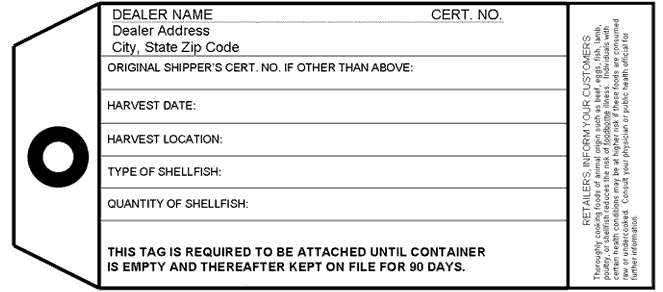
While both of the previous examples contain the minimum required information in the required order, many firms also customize the tags with additional information. Such information might include space for the consignee’s address, date shipped, reshipper certification number, date reshipped, and a “Perishable- Keep Refrigerated” statement. Some firms also opt to preprint the types of shellfish with a check-off space. When customizing the tag, the order of the minimum required information cannot be changed.
This tag is an example of a dealer tag which meets the NSSP requirements and has been modified to include additional information. It also has the pin feed feature to allow printing on the dot matrix printer.
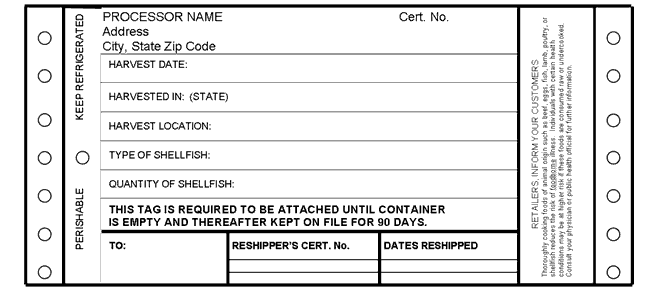
This tag is an example of a tag for depurated shellstock with the minimum NSSP required information in the required order.
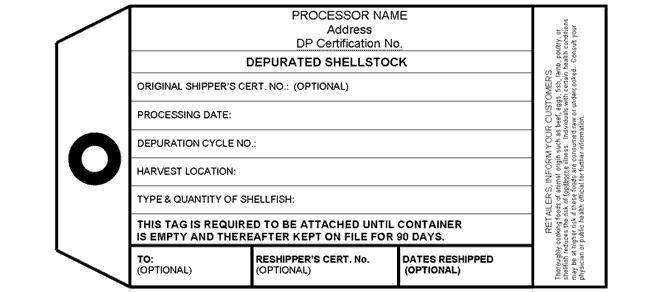
When shellstock is transported interstate and placed in wet storage, special tagging requirements must be met. See the NSSP Model Ordinance for details. This tag is an example of a dealer tag modified for labeling product transported across State lines and subsequently wet stored.
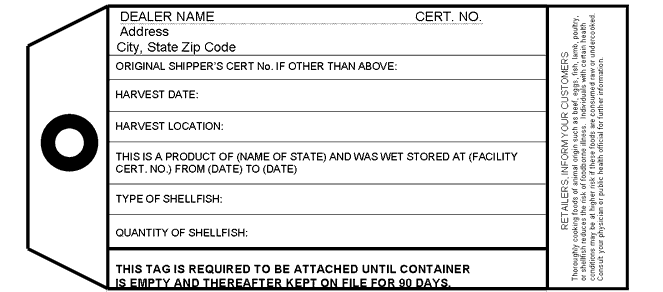
Tags are available through various sources. In some states, the Authority sells the tags which are sequentially numbered for accountability. There are also grower’s associations which bulk purchase tags for their members at considerable savings. Individual dealers can also have tags printed at local print shops.
Tyvek is one example of a durable waterproof material commonly used for shellstock tags.
Some states require additional information on tags which exceeds the NSSP requirements. A dealer should verify the receiving state’s requirements prior to shipment to that state.